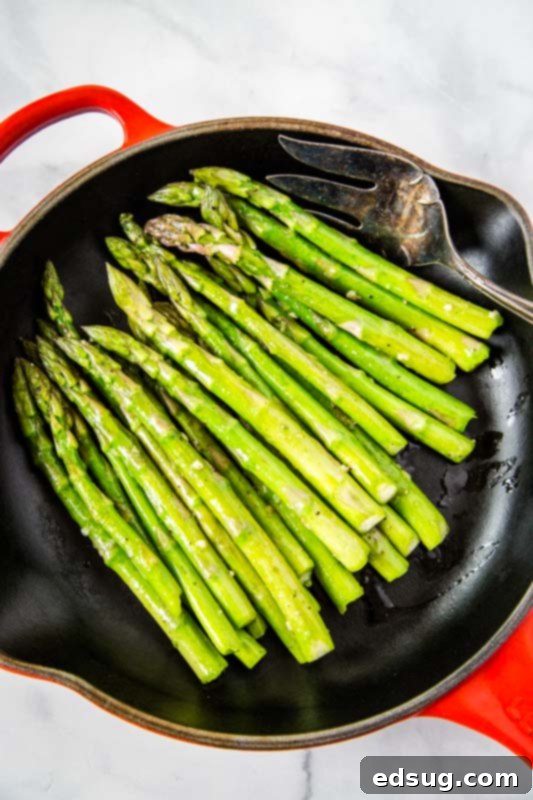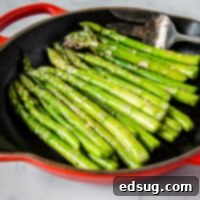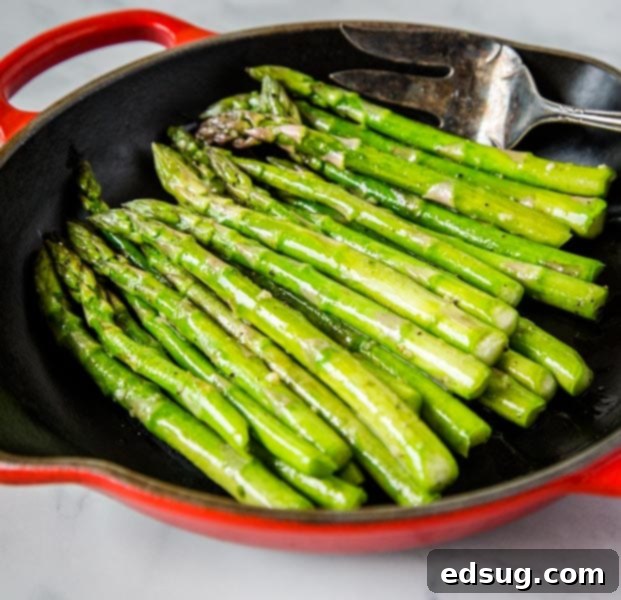Perfectly Sautéed Asparagus: Your Ultimate Quick & Healthy Side Dish
Asparagus, with its vibrant green spears and delicate earthy flavor, is a true harbinger of spring, but a delightful vegetable to enjoy year-round. Beyond its appealing taste and striking color, it’s packed with essential vitamins, minerals, and potent antioxidants, making it a nutritional powerhouse for any diet. While there are many fantastic ways to prepare asparagus – from roasting to steaming – sautéing stands out as one of the quickest and most rewarding methods. In mere minutes, you can transform fresh asparagus into a tender-crisp side dish that brightens any meal. This easy recipe, featuring simple ingredients like butter, olive oil, and aromatic garlic, delivers incredible flavor with minimal effort, making it ideal for busy weeknights, elegant dinner parties, or any occasion craving a healthy, vibrant vegetable.

For many, asparagus might have been an acquired taste, perhaps first enjoyed roasted to perfection. However, experimenting with different cooking methods quickly reveals the versatility of this fantastic vegetable. When it comes to crafting a complete meal, side dishes often feel like an afterthought, yet they can truly elevate the main course. That’s why having a repertoire of quick and easy side dish recipes, like this sautéed asparagus, is invaluable. They come together in a flash, allowing you to put a healthy, flavorful meal on the table without the stress of extensive preparation.
Why Sauté Asparagus? The Benefits of This Speedy Side
Among the various cooking methods for asparagus, sautéing truly shines for its speed, simplicity, and ability to preserve the vegetable’s natural crunch while imparting a delightful tenderness. Unlike boiling, which can sometimes result in waterlogged spears and leech out valuable nutrients, or lengthy roasting processes, sautéing offers a rapid burst of high heat. This quick cooking method caramelizes the exterior ever so slightly, enhancing the asparagus’s inherent sweetness and locking in its fresh, bright flavors. The result is consistently tender-crisp asparagus with a vibrant green hue, making it an irresistible and visually appealing addition to any plate.
Choosing the Best Asparagus and Essential Preparation
The foundation of any great asparagus dish is, of course, fresh, high-quality asparagus. Knowing how to select and prepare it correctly ensures the best possible texture and flavor in your final dish.
- Selection: Look for firm, bright green stalks with tight, closed tips. Avoid any spears that appear limp, shriveled, or have open, flowering tips, as these indicate older asparagus. While available year-round, asparagus is in its peak season during spring, offering the freshest and most flavorful options.
- Size Matters: Aim for asparagus spears that are about the thickness of a pencil. Very thin spears can cook too quickly and turn mushy, while overly thick or fat ones tend to be tough and require longer cooking times, sometimes even benefiting from blanching beforehand. Medium-sized spears strike the perfect balance for sautéing.
- Trimming for Tenderness: The woody, fibrous ends of asparagus are unpalatable. The simplest way to remove them is the “snap test”: hold a spear in both hands and gently bend it until it naturally breaks. This break point usually indicates where the tough part ends and the tender part begins. Alternatively, snap one spear, then use that as a guide to trim the rest of the bunch with a knife, ensuring uniform length.
- Quick Rinse: Before cooking, give your asparagus a quick rinse under cold water to remove any dirt or grit. Pat them dry thoroughly, as excess moisture can hinder proper sautéing and lead to steaming instead of browning.
What You’ll Need for Sautéed Asparagus
Crafting this quick and flavorful side dish requires just a handful of staple ingredients. Each plays a crucial role in developing the asparagus’s delicious taste and texture. (Be sure to scroll to the bottom of the post for the FULL PRINTABLE recipe card.)
- Asparagus: Approximately 1 pound, fresh and trimmed as described above. This is the star of our show, offering its unique spring flavor and vibrant color.
- Butter: A tablespoon of butter adds a rich, luxurious flavor and helps the asparagus develop a beautiful golden hue. It contributes significantly to the overall deliciousness.
- Olive Oil: Combining butter with a tablespoon of olive oil is key. Olive oil has a higher smoke point than butter, which prevents the butter from burning too quickly while providing enough fat for effective sautéing and a subtle, complementary flavor.
- Garlic: One clove of minced garlic infuses the asparagus with an irresistible aromatic depth. Freshly minced garlic yields the best results, adding a pungent yet sweet note that pairs perfectly with asparagus.
- Salt & Pepper: Simple sea salt and freshly ground black pepper are your basic seasoning agents. They enhance the asparagus’s natural flavors without overpowering them. This foundational seasoning allows the natural taste of the asparagus to shine, serving as a perfect canvas for further customization if desired.

How to Sauté Asparagus: A Simple Step-by-Step Guide
Sautéing asparagus is incredibly straightforward and yields impressive results. Follow these steps for perfectly cooked, tender-crisp spears every time:
- Heat the Fats: In a large skillet, add the butter and olive oil. Place the skillet over medium-high heat. Allow the butter to melt completely and start to sizzle with the olive oil. The large surface area of the skillet is crucial here, as it ensures the asparagus has enough room to cook evenly without overcrowding, which would lead to steaming instead of sautéing.
- Add Asparagus: Carefully add the trimmed asparagus spears to the hot skillet, spreading them out into as single a layer as possible. Let the asparagus cook for 3-4 minutes. You will want to use tongs to rotate the spears frequently, ensuring all sides get cooked and lightly browned. Watch for a vibrant, dark bright green color to develop, indicating they are cooking beautifully and retaining their crispness.
- Season and Finish: Once the asparagus has developed its vibrant color and a slight char, add the minced garlic to the pan. Continue to cook for another minute, tossing everything together to coat the asparagus evenly. You’ll know it’s ready when you can start to smell the fragrant garlic permeating the air. This late addition prevents the garlic from burning, which can turn it bitter. Finally, season generously with salt and pepper to taste. That’s it! Your perfectly sautéed asparagus is now ready to serve immediately.
Perfect Pairings: What to Serve With Sautéed Asparagus
The beauty of sautéed asparagus lies in its incredible versatility. Its lightly seasoned, fresh flavor won’t compete with other dishes, making it a stellar companion for almost any meal. Here are just a few ideas to inspire your next dinner:
- Poultry: It’s a classic pairing for chicken and turkey. Try it alongside Honey Dijon Chicken or Garlic Tomato Baked Chicken.
- Pork: The earthy notes of asparagus complement pork beautifully. Serve it with Oven Baked Pork Chops or rich Smothered Pork Chops.
- Beef & Lamb: A simple steak or tender lamb chops are elevated by the addition of vibrant asparagus.
- Meatloaf: Add a fresh green counterpoint to hearty dishes like Turkey Meatloaf.
- Fish: The delicate flavor of asparagus pairs wonderfully with flaky white fish or baked salmon.
- Eggs: For a sophisticated brunch, serve sautéed asparagus alongside poached eggs or folded into an omelet.
- Pasta & Grains: Toss it into a light pasta dish or serve it as a vibrant side to risotto or quinoa.

Expert Tips & Flavorful Variations for Your Sautéed Asparagus
Achieving perfectly sautéed asparagus is simple, but a few key tips can elevate your dish. Don’t be afraid to experiment with seasonings to match your meal!
- Don’t Overcrowd the Pan: This is arguably the most crucial tip for sautéing. If you’re cooking a larger batch, work in batches. Overcrowding the skillet will lower the pan temperature and cause the asparagus to steam instead of sauté, resulting in a less desirable soft, dull texture rather than a tender-crisp snap and vibrant color.
- Achieve the Perfect Tender-Crisp: Keep a close eye on your asparagus as it cooks. You’re aiming for a bright green color and a texture that’s tender enough to bite through easily but still has a slight “snap” to it. Overcooking will lead to limp, mushy, and less flavorful asparagus.
- Fresh Asparagus is Key: While often available year-round, asparagus is truly at its peak in the spring months. That’s when you’ll find the freshest, most flavorful, and often most affordable spears. Look for stalks that are about the thickness of a pencil for the best results in sautéing. Really thin ones can overcook and turn mushy too fast, while very thick, fat ones can be tough.
- Seasoning Variations: While salt and pepper provide a delicious basic seasoning, don’t hesitate to get creative.
- Lemon Brightness: A squeeze of fresh lemon juice right before serving instantly brightens the flavors and adds a zesty tang.
- Cheesy Goodness: A sprinkle of freshly grated Parmesan cheese during the last minute of cooking or just before serving adds a salty, umami depth.
- Herbaceous Notes: Freshly chopped herbs like dill, chives, parsley, or a pinch of Italian seasoning can add another layer of aroma and flavor.
- Spicy Kick: For a little heat, add a dash of red pepper flakes along with the garlic.
- Sweet & Tangy: A drizzle of balsamic glaze after cooking can add a beautiful sweet and tangy counterpoint.
- Use a Large Skillet: As mentioned, even if you’re not cooking a huge amount, a large skillet (like a 10-12 inch cast iron or stainless steel pan) is beneficial. It provides ample space for the asparagus spears to lay in a single layer, ensuring that each piece makes contact with the hot surface, leading to even cooking and delicious browning.

The Nutritional Powerhouse: Health Benefits of Asparagus
Beyond its delicious taste and ease of preparation, asparagus is a nutritional superstar. It’s a low-calorie vegetable, making it an excellent choice for health-conscious diets. Asparagus is particularly rich in Vitamin K, essential for blood clotting and bone health, and Folate (Vitamin B9), which plays a crucial role in cell growth and DNA formation. It also provides good amounts of Vitamin A, Vitamin C, and Vitamin E, powerful antioxidants that help protect your body’s cells from damage. Furthermore, asparagus is a good source of dietary fiber, aiding in digestion and promoting gut health, and contains various minerals like iron and potassium. Incorporating sautéed asparagus into your meals is an easy and delicious way to boost your nutrient intake.
Storing & Reheating Sautéed Asparagus
To ensure you get the most out of your asparagus, both fresh and cooked, proper storage is key:
- Storing Fresh Asparagus: To keep fresh asparagus crisp for up to a week, trim about an inch off the ends, then stand the spears upright in a jar or glass with about an inch of water at the bottom. Cover the tips loosely with a plastic bag and refrigerate.
- Storing Cooked Asparagus: If you have leftovers, allow the sautéed asparagus to cool completely before transferring it to an airtight container. Store it in the refrigerator for 3-4 days.
- Reheating Sautéed Asparagus: While best enjoyed fresh, cooked asparagus can be reheated. To help it regain some crispness, gently warm it in a dry skillet over medium heat for a few minutes, stirring occasionally. Alternatively, you can microwave it briefly, but be cautious not to overcook, as this can make it soggy.
Frequently Asked Questions About Sautéed Asparagus
- Q: Can I use frozen asparagus for this recipe?
- A: While fresh asparagus yields the best texture for sautéing, you can use frozen. Make sure to thaw it completely first and then pat it very dry with a paper towel to remove any excess moisture. This prevents it from steaming in the pan. The cooking time might need slight adjustment, as frozen asparagus tends to be a bit softer.
- Q: How do I know when my asparagus is perfectly cooked?
- A: Perfectly sautéed asparagus should be vibrantly bright green and tender-crisp. It should still have a slight “snap” when you bite into it or bend it, but be easily pierced with a fork. Avoid cooking until it’s dull green or completely limp.
- Q: What’s the best way to trim the woody ends?
- A: The most reliable method is the “snap test.” Hold an asparagus spear in both hands and gently bend it until it naturally breaks where the woody part ends. Use this broken spear as a guide to trim the remaining stalks with a knife for uniform length.
- Q: Can I make this recipe ahead of time?
- A: Sautéed asparagus is at its absolute best when served immediately after cooking, as this is when its tender-crisp texture is most pronounced. While leftovers can be stored and reheated, they will lose some of their crispness.
- Q: Is asparagus truly good for you?
- A: Absolutely! Asparagus is a nutritional powerhouse. It’s low in calories, high in fiber, and packed with essential vitamins like K, A, C, E, and B-vitamins (especially folate), along with beneficial antioxidants, all contributing to overall health and wellness.
Asparagus is such a great vegetable—healthy, versatile, and something that goes with just about everything! And when it can be on the table in about 10-15 minutes, that makes it a win all around! If you’re a fan of quick and delicious asparagus, you might also love our Air Fryer Asparagus, which delivers perfectly browned and tender spears in no time.
More Delicious Side Dish Recipes to Explore
Looking for more easy and flavorful side dishes to complement your meals? Check out some of our other favorites:
- Zucchini Fritters
- Crispy Cauliflower Fritters
- Asian Napa Cabbage Slaw
- Mushroom Rice Pilaf
- Smashed Potatoes

Sautéed Asparagus
Erin Sellin
5 minutes
10 minutes
15 minutes
4
Pin Recipe
Rate Recipe
Print Recipe
Ingredients
-
1
bunch of asparagus,
approx 1 pound, ends trimmed -
1
Tablespoon
butter -
1
Tablespoon
olive oil -
1
clove
garlic,
minced -
salt and pepper to taste
Instructions
-
Trim the woody ends of the asparagus. You can do this by holding a spear and bending it until it naturally breaks. Use this as a guide to trim the rest of the bunch with a knife. Discard the ends.1 bunch of asparagus
-
In a large skillet, melt the butter and olive oil together over medium-high heat until it begins to sizzle.1 Tablespoon butter,
1 Tablespoon olive oil -
Add the trimmed asparagus to the pan in a single layer and cook for 6-8 minutes, rotating occasionally with tongs until the spears are bright green, lightly browned, and still slightly crisp (tender-crisp).
-
Add the minced garlic and cook for about 1 minute more, stirring constantly, until the garlic becomes fragrant. Be careful not to burn the garlic.1 clove garlic
-
Season generously with salt and pepper to taste. Serve your delicious sautéed asparagus immediately and enjoy!salt and pepper to taste
Nutrition
Calories:
56
kcal
|
Fat:
6
g
|
Saturated Fat:
2
g
|
Polyunsaturated Fat:
4
g
|
Cholesterol:
8
mg
|
Sodium:
97
mg
Nutrition information is automatically calculated, so should only be used as an approximation.
Additional Info
Erin Sellin
5 minutes
10 minutes
15 minutes
Side Dish Recipes
American
4
56
Like this recipe? Leave a comment below!
I created a fun group on Facebook, and I would love for you to join us! It’s a place where you can share YOUR favorite recipes, ask questions, and see what’s new at Dinners, Dishes and Desserts (so that you never miss a new recipe)!
Be sure to follow me on Instagram and tag #dinnersdishes so I can see all the wonderful DINNERS, DISHES, AND DESSERTS recipes YOU make!
Be sure to follow me on my social media, so you never miss a post!
Facebook | Twitter | Pinterest | Instagram
